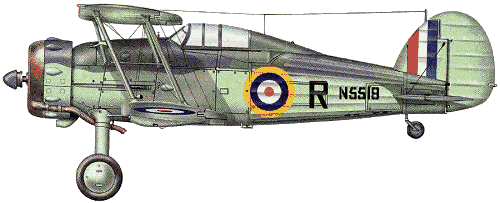 |
Gloster Gladiator1934 |  |
| FIGHTER | Virtual Aircraft Museum / United Kingdom / Gloster |
 |
An improved version of the high-performance Gauntlet, the Gladiator represented the pinnacle of biplane development in Britain. With the Gloster SS.37, H. P. Folland endeavoured to satisfy the requirement of the Air Ministry's F.7/30 specification which the Gauntlet had failed to meet - although this latter aircraft was undoubtedly the best offering of the British aircraft industry at that time. However the Gauntlet's maximum speed was some 32km/h below the F.7/30 requirement, which also called for an offensive armament of four machine-guns. Clearly the Gauntlet represented a close approach to the requirement and Folland decided that aerodynamic improvements of the basic Gauntlet fuselage (together with installation of a more powerful engine) should prove adequate for the Gloster design to be ordered into production. It had been intimated by the Air Ministry that submissions for the F.7/30 requirement which were powered by the new Rolls-Royce Goshawk evaporative-cooled engine would receive favourable consideration. This meant that of the seven other contenders for this contract, five were designed to utilise the Goshawk. When this engine failed, it eliminated most of Gloster's competitors. Folland, however, pinned his hopes on the Bristol Mercury ME.30 radial which was then promising a power output of some 521.6kW. But it was not available when the prototype SS.37 was nearing completion and the first flight, on 12 September 1934, was made with a 395kW Mercury IV. Early tests, following the prototype's first flight, showed that the target maximum speed was in sight. On 1 July 1935 the Air Ministry ordered 23 aircraft, as Gladiators, one going to Greece. These were powered by the 618.5kW Bristol Mercury IX. Other improvements included an enclosed cockpit with a sliding canopy and a redesigned tail unit. Gladiators first entered service with No 72 Squadron in early 1937. But despite the aura of glamour and invincibility which always seems to be associated with these aircraft, it is an undeniable fact that they were virtually outdated at that time - a biplane in a monoplane era. The early Gladiator I were followed by an improved Gladiator II in 1938 powered by the Bristol Mercury VIIIA engine. Other improvements comprised the addition of a battery and electric starter and the inclusion of a full blind-flying instrument panel. Production also included 60 Sea Gladiators for the FAA. Generally similar to the Gladiator II, they differed by being equipped for catapult launch and deck landing - although not intended for operational use from carriers - and carried an inflatable dinghy in a fairing beneath the lower wing centre-section. Of the total 747 Gladiators which were built, almost 30% were exported, serving with the armed forces of Belgium, China, Finland, Greece, Iraq, Irish Republic, Latvia, Lithuania, Portugal, Norway and Sweden. In addition some aircraft transferred from the RAF operated with Egyptian and South African forces. When World War II started the Gladiator - which at the peak of its deployment was flown by 29 home and 11 overseas squadrons - had largely been superseded. Nevertheless many remained in RAF service until early 1945 and were the last biplane fighters to serve with both the RAF and Royal Navy. Many of the stirring stories of Gladiator operations must be regarded as apocryphal: in truth it was the courage of its pilots rather than its ability as a fighter which notched up its successes. But it cannot be denied that the Gladiator was a classic biplane with superb handling characteristics. The 'communications' Gladiator of one RAF station had an almost unbelieveable performance in the hands of the unit's chief flying instructor. Time and again he could produce an impeccable and accurate side-slip landing, a demonstration not only of his skill, but of the controllability and manoeuvrability of this beautiful aeroplane.

|  COMPANY PROFILE | ||||||||||||||||||||||||||||||||||||||||||||||||
 |

|

